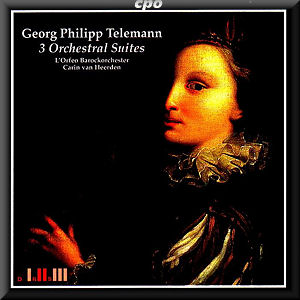 |
 |
|


alternatively
CD: MDT
AmazonUK
AmazonUS
Sound
Samples & Downloads
|
Georg Philipp TELEMANN (1681-1767)
Overture for flute pastorelle, strings and bc in E flat (TWV 55,
Es2) [20:22]
Overture for 2 oboes, strings and bc in F (TWV 55, F14) [16:46]
Overture for recorder, strings and bc in A minor (TWV 55, a2) [31:30]
 Carin van Heerden (recorder)
Carin van Heerden (recorder)
L'Orfeo Barockorchester/Carin van Heerden
rec. 27-30 March 2006, Alte Kirche in Boswil, Germany. DDD
 CPO 777 218-2 [68:50]
CPO 777 218-2 [68:50] 
|
|
|
The three orchestral overtures on this disc are just a small
proportion of what Telemann contributed to this genre. Several
times in his career he was at places where he could become acquainted
with the French style. He became a staunch admirer, and that
resulted in a large number of orchestral overtures - basically
modelled after Jean-Baptiste Lully. He preferred these to solo
concertos, which was an Italian form.
Most of Telemann's overtures have been preserved in the archive
of the court of Darmstadt. Prince Ernst Ludwig, Landgrave of
Hesse, was very impressed by the French style and engaged several
French musicians for his chapel. Telemann's friend Christoph
Graupner was appointed Kapellmeister in Darmstadt in
1712, and he composed a number of overtures. Together Graupner
and Johann Samuel Endler – his vice-Kapellmeister
since 1723 - also collected and copied a large number of similar
works, among them many by Telemann.
Some of Telemann's overtures contain a solo part for one or
several instruments. Two overtures on this disc have solo parts
for the recorder. These were very likely written for Johann
Michael Böhm. From 1711 to 1729 he was at the service of Prince
Ernst Ludwig, and when he married Susanna Elisabeth Textor in
Frankfurt in 1720 he became Telemann's brother-in-law. Böhm
was a famous player of the transverse flute and also played
the recorder and the oboe. It is an indication of the high reputation
of Telemann that Böhm and Endler were involved in a kind of
competition about the number of works by Telemann they owned.
The first Overture on this disc is not very well-known. The
scoring of the solo part is problematic. The score indicates
a flute pastorelle, but it isn't quite clear what this
means. "In view of the fact that the solo part operates
with striking frequency in the lower register, the (little)
fourth flute (Quartflöte, flûte de quatre) would be the
most logical choice among the selection of (conically bored)
recorders in use during Telemann's lifetime", Christian
Moritz-Bauer writes in his programme notes. That is the instrument
Carin van Heerden plays here. The opening overture is in the
usual ABA form. In the A section the flute plays colla parte
with the first violin, whereas in the B section it has its own
part. The same happens in menuet I and II; in menuet I the interventions
of the flute are short, sometimes just a couple of notes, and
again it mostly plays with the first violin. In the bourrée
I the flute is imitated in the strings, in particular in the
closing episode. In the last movement, a gigue, the recorder
imitates birdsong.
The other Overture for recorder and strings is one of Telemann's
best-known compositions. The recorder part, played here on the
treble instrument, is technically demanding. This work is one
of the most challenging compositions for any recorder player.
It is considered a rather late work, written when Telemann was
already working in Hamburg. It moves away from the original
French concept of the orchestral overture, especially as the
third movement is an 'air à l'Italien', a movement which could
well figure in an Italian solo concerto. Christian Moritz-Bauer
compares it with a dacapo aria. The second movement is more
French: a character piece, called Les Plaisirs. The work
ends with a polonoise, another form of which Telemann
was very fond.
It appears also in the second Overture on this disc, scored
for two oboes, strings and bc. This is considered a much earlier
work and closer to the Lullian overture, as the oboes don't
have independent parts but play colla parte with the
two violins throughout. The rigaudon is characterised by strong
accents, the fifth movement is a rondeau, a favourite
form in France in the early 18th century. The seventh movement
is a character piece, called La Chasse (the hunt), and
the Overture ends with an elegant menuet.
This disc is mainly interesting because of the Overtures in
E flat and in F. I can't remember ever having heard them before.
They’re nice works which are well worth listening to. The Overture
in a minor is available in a number of recordings, and this
version is not going to be my favourite. Carin van Heerden plays
well, but I find the 'air à l'Italien' a little disappointing,
especially in regard to ornamentation. The performance is also
dynamically a little flat. It is probably because the dynamic
range of the recorder is relatively limited that the ensemble
holds back in this regard as well. The same happens in the Overture
in E flat. There are stronger dynamic contrasts in the Overture
in F. Generally I would have liked more engaging and really
compelling performances.
The timings of the first and third overture on the rear insert
are confused, and so is the information in the booklet regarding
the recorders used in these overtures.
Johan van Veen
see also review by Brian
Wilson
|
|
|

